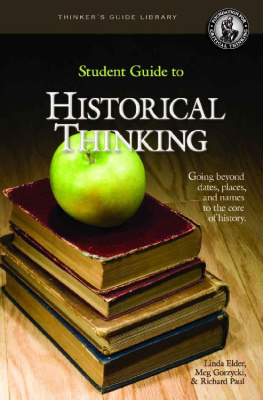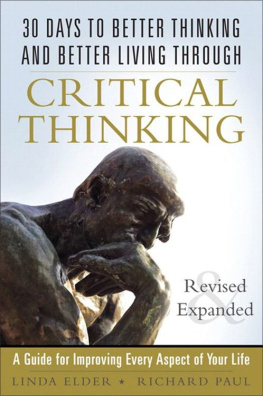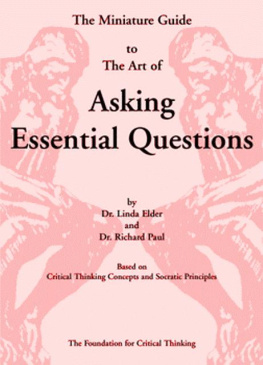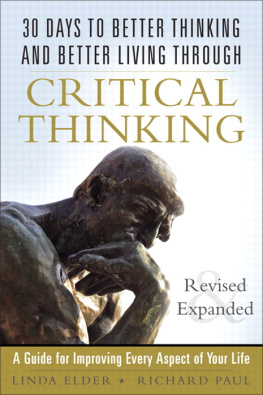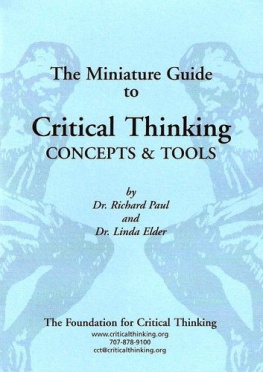Linda Elder - Student Guide to Historical Thinking (Thinkers Guide Library)
Here you can read online Linda Elder - Student Guide to Historical Thinking (Thinkers Guide Library) full text of the book (entire story) in english for free. Download pdf and epub, get meaning, cover and reviews about this ebook. year: 2014, publisher: Foundation for Critical Thinking, genre: Religion. Description of the work, (preface) as well as reviews are available. Best literature library LitArk.com created for fans of good reading and offers a wide selection of genres:
Romance novel
Science fiction
Adventure
Detective
Science
History
Home and family
Prose
Art
Politics
Computer
Non-fiction
Religion
Business
Children
Humor
Choose a favorite category and find really read worthwhile books. Enjoy immersion in the world of imagination, feel the emotions of the characters or learn something new for yourself, make an fascinating discovery.
- Book:Student Guide to Historical Thinking (Thinkers Guide Library)
- Author:
- Publisher:Foundation for Critical Thinking
- Genre:
- Year:2014
- Rating:4 / 5
- Favourites:Add to favourites
- Your mark:
- 80
- 1
- 2
- 3
- 4
- 5
Student Guide to Historical Thinking (Thinkers Guide Library): summary, description and annotation
We offer to read an annotation, description, summary or preface (depends on what the author of the book "Student Guide to Historical Thinking (Thinkers Guide Library)" wrote himself). If you haven't found the necessary information about the book — write in the comments, we will try to find it.
Student Guide to Historical Thinking (Thinkers Guide Library) — read online for free the complete book (whole text) full work
Below is the text of the book, divided by pages. System saving the place of the last page read, allows you to conveniently read the book "Student Guide to Historical Thinking (Thinkers Guide Library)" online for free, without having to search again every time where you left off. Put a bookmark, and you can go to the page where you finished reading at any time.
Font size:
Interval:
Bookmark:
to
Thinking...
Going beyond dates, places, and names to the core of history
by Linda Elder, Meg Gorzycki, and Richard Paul

Foundation
for
Critical Thinking
ISBN # 978-0-944583-46-3 (13 digit)
ISBN # 0-944583-46-6 (10 digit)
1. History. 2. History instruction. 3. Critical thinking.
2011931762
If we are to create fairminded critical societies, societies in which all peoples, nationsand cultures come to value fairminded critical thinking, we will need to think criticallyabout history. We will need to see the past in ways that are less biased. We will need to useour understanding of the past to help us make better decisions in the present and future.
The purpose of this guide is to help you begin to understand history as a way ofthinking, as a system of understandings. History is not a list of dates, names, and eventsto store up in your memory. It is a catalog of stories told about the past that, when toldand understood insightfully and deeply, can help us live better in the future.
Every historical account has been told from some perspective, and that perspectivecan be analyzed and assessed using the tools of critical thinking. In fact, if you dontanalyze and assess historical thought using these tools, you will likely uncriticallyaccept views about the past that are distorted, illogical, based in biases or prejudices,or just plain nonsense. We believe that the concepts and principles of critical thinkingintroduced in this guide are essential to any serious study of history. All the besthistorians use these tools, though perhaps not explicitly. When you master criticalthinking as it applies to history, you learn history. At the same time, you can learn thetools of critical thinking as you study history. But you cannot effectively study historywithout these tools.
In this guide, we begin with some essential understandings about the relationshipbetween history and thinking and about the concept of historical thinking itself. In PartTwo we offer suggestions for how to become a master student in history. In Part Threewe introduce the basic concepts of critical thinking and how they apply to the study ofhistory. In Part Four we briefly discuss some problems and issues in historical thinking.
This is not a guide to be read once; rather, it should be read and applied and read andapplied, again and again. The principles that underlie it lend themselves to application atdeeper and deeper levels.
raise vital historical questions and problems, formulating them clearly and precisely;
gather and assess historical information, using historical ideas to interpret thatinformation insightfully;
come to well-reasoned historical conclusions and interpretations, checking themagainst relevant criteria and standards;
adopt the point of view of the skilled historian, recognizing and assessing, as needbe, historical assumptions, implications, and practical consequences;
communicate effectively with others using the language of history and the languageof educated public discourse; and
relate what one is learning in history to other subjects and to what is significant inhuman life.
To become a skilled historical thinker is to become a self-directed, self-disciplined, self-monitored, and self-corrective historical thinker, who assents to rigorous standards of thought and mindful command of their use.
Font size:
Interval:
Bookmark:
Similar books «Student Guide to Historical Thinking (Thinkers Guide Library)»
Look at similar books to Student Guide to Historical Thinking (Thinkers Guide Library). We have selected literature similar in name and meaning in the hope of providing readers with more options to find new, interesting, not yet read works.
Discussion, reviews of the book Student Guide to Historical Thinking (Thinkers Guide Library) and just readers' own opinions. Leave your comments, write what you think about the work, its meaning or the main characters. Specify what exactly you liked and what you didn't like, and why you think so.

